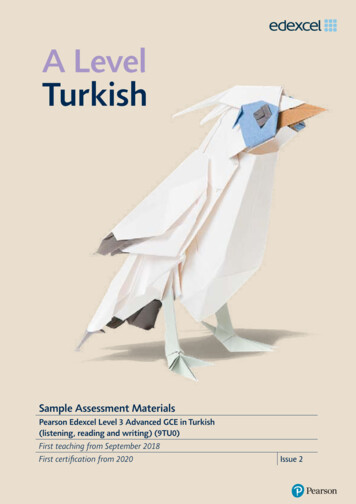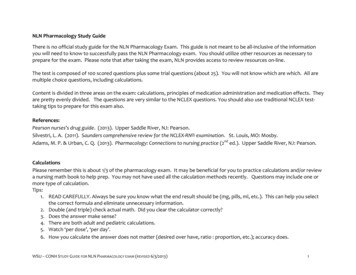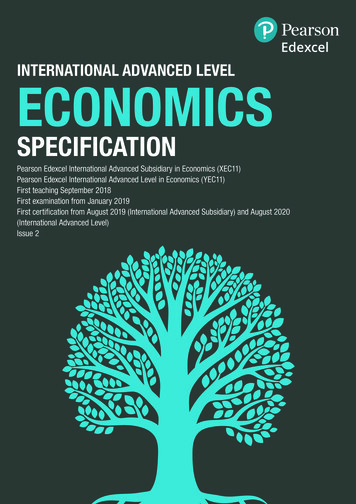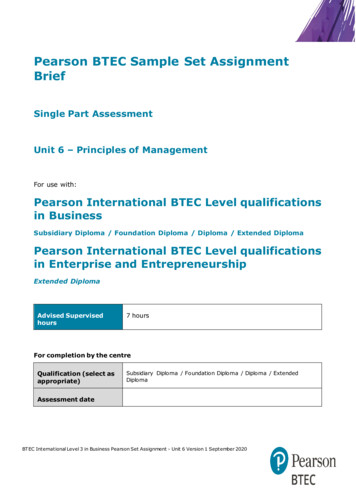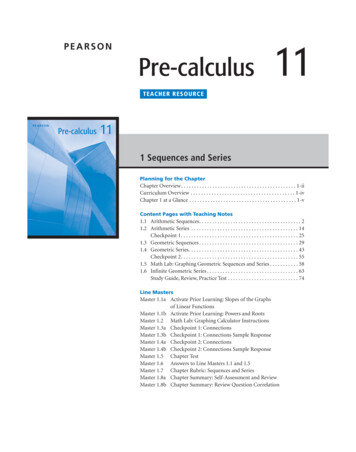
Transcription
01 ch01 pre-calculas11 wncp sb.qxd1/17/119:07 AMPage 1-iPEARSONPre-calculus11TEACHER RESOURCE1 Sequences and SeriesPlanning for the ChapterChapter Overview . . . . . . . . . . . . . . . . . . . . . . . . . . . . . . . . . . . . . . . . . . . . 1-iiCurriculum Overview . . . . . . . . . . . . . . . . . . . . . . . . . . . . . . . . . . . . . . . . 1-ivChapter 1 at a Glance . . . . . . . . . . . . . . . . . . . . . . . . . . . . . . . . . . . . . . . . . 1-vContent Pages with Teaching Notes1.1 Arithmetic Sequences. . . . . . . . . . . . . . . . . . . . . . . . . . . . . . . . . . . . . . . 21.2 Arithmetic Series . . . . . . . . . . . . . . . . . . . . . . . . . . . . . . . . . . . . . . . . . 14Checkpoint 1. . . . . . . . . . . . . . . . . . . . . . . . . . . . . . . . . . . . . . . . . . . . . 251.3 Geometric Sequences . . . . . . . . . . . . . . . . . . . . . . . . . . . . . . . . . . . . . . 291.4 Geometric Series. . . . . . . . . . . . . . . . . . . . . . . . . . . . . . . . . . . . . . . . . . 43Checkpoint 2. . . . . . . . . . . . . . . . . . . . . . . . . . . . . . . . . . . . . . . . . . . . . 551.5 Math Lab: Graphing Geometric Sequences and Series . . . . . . . . . . . 581.6 Infinite Geometric Series . . . . . . . . . . . . . . . . . . . . . . . . . . . . . . . . . . . 63Study Guide, Review, Practice Test . . . . . . . . . . . . . . . . . . . . . . . . . . . 74Line MastersMaster 1.1a Activate Prior Learning: Slopes of the Graphsof Linear FunctionsMaster 1.1b Activate Prior Learning: Powers and RootsMaster 1.2 Math Lab: Graphing Calculator InstructionsMaster 1.3a Checkpoint 1: ConnectionsMaster 1.3b Checkpoint 1: Connections Sample ResponseMaster 1.4a Checkpoint 2: ConnectionsMaster 1.4b Checkpoint 2: Connections Sample ResponseMaster 1.5 Chapter TestMaster 1.6 Answers to Line Masters 1.1 and 1.5Master 1.7 Chapter Rubric: Sequences and SeriesMaster 1.8a Chapter Summary: Self-Assessment and ReviewMaster 1.8b Chapter Summary: Review Question Correlation
01 ch01 pre-calculas11 wncp sb.qxd1/17/119:07 AMPage 1-iiC H A P T E R OV E RV I E WBackgroundIn grade 9, students graphed linear relations and solved linear equations,which is necessary background knowledge for understanding arithmeticsequences and series. In grade 10, these concepts are extended to includelinear functions. By the time students enter grade 11, they should be ableto determine the slope of the graph of a linear function. This is related tothe constant difference in an arithmetic sequence.In grade 9, students were introduced to powers and roots (limited towhole number exponents) and square roots of perfect squares. In grade 10,these concepts were extended to include integral and rational exponentsand to determining nth roots. This knowledge is a prerequisite for solvingproblems involving geometric sequences and series.RationaleSequences and series are introduced in grade 11. Students use theirunderstanding of linear functions to develop the properties of arithmeticsequences and series, then solve related problems. They derive rules fordetermining the nth term of an arithmetic sequence and the sum of thefirst n terms of an arithmetic series.Students are introduced to geometric sequences and series, anddistinguish them from arithmetic sequences and series. They derive rulesfor determining the nth term of a geometric sequence and the sum of thefirst n terms of a geometric series. Students solve problems that can bemodelled using geometric sequences and series.The concept of convergence and divergence of infinite geometricsequences and series is introduced through graphing. Students see thatthe points on some graphs approach a horizontal line while the points onother graphs move away from a horizontal line. They develop an informalunderstanding about the role of the common ratio in determiningconvergence and divergence, and derive a rule to determine whether aninfinite geometric sequence or series converges. Students learn that theterms of a convergent geometric sequence approach 0 as the termnumber increases, and they derive a rule to determine the sum of aninfinite geometric series that converges.1-iiChapter 1: Sequences and Series978-0-321-74265-0 Copyright 2011 Pearson Canada Inc.
01 ch01 pre-calculas11 wncp sb.qxd1/17/119:07 AMPage 1-iiiConcept SummaryBig IdeasApplying the Big Ideas An arithmetic sequence is related to a linear functionand is created by repeatedly adding a constant to aninitial number. An arithmetic series is the sum of theterms of an arithmetic sequence.This means that: The common difference of an arithmetic sequence isequal to the slope of the line through the points of thegraph of the related linear function. Rules can be derived to determine the nth term of anarithmetic sequence and the sum of the first n terms ofan arithmetic series. A geometric sequence is created by repeatedlymultiplying an initial number by a constant. A geometricseries is the sum of the terms of a geometric sequence. The common ratio of a geometric sequence can bedetermined by dividing any term after the first termby the preceding term. Rules can be derived to determine the nth term of ageometric sequence and the sum of the first n termsof a geometric series. Any finite series has a sum, but an infinite geometricseries may or may not have a sum. The common ratio determines whether an infinite serieshas a finite sum.978-0-321-74265-0 Copyright 2011 Pearson Canada Inc.Chapter Overview1-iii
01 ch01 pre-calculas11 wncp sb.qxd1/17/119:07 AMPage 1-ivC U R R I C U L U M OV E RV I E WGrade 9Foundations ofMathematics andPre-calculus 10Pre-calculus 11Pre-calculus 12Chapter 1 OutcomesPR2 Graph linear relations,analyze the graph andinterpolate or extrapolateto solve problems.PR3 Model and solveproblems using linearequations.N1 Demonstrate anunderstanding of powerswith integral bases(excluding base 0) andwhole numberexponents by: representing repeatedmultiplication usingpowers using patterns to showthat a power with anexponent of zero isequal to one solving problemsinvolving powers.1-ivRF3 Demonstrate anunderstanding of slopewith respect to: rise andrun; line segments andlines; rate of change;parallel lines; perpendicularlines.RF4 Describe andrepresent linear relations,using: words; orderedpairs; tables of values;graphs; equations.RF9 Analyze arithmeticsequences and series tosolve problems.[CN, PS, R, T]RF10 Analyze geometricsequences and series tosolve problems.[PS, R, T]RF9 Graph and analyzeexponential andlogarithmic functions.RF10 Solve problems thatinvolve exponential andlogarithmic equations.RF5 Determine thecharacteristics of thegraphs of linear relations,including the: intercepts;slope; domain; range.AN3 Demonstrate anunderstanding of powerswith integral and rationalexponents.Chapter 1: Sequences and Series978-0-321-74265-0 Copyright 2011 Pearson Canada Inc.
01 ch01 pre-calculas11 wncp sb.qxd1/17/119:07 AMPage 1-vC H A P T E R 1 AT A G L A N C ELessonTimingMaterials andResourcesProgram SupportChapter Opener, page 1Review prior skills, as relevant.Masters 1.1a, 1.1bActivate Prior LearningMaster 1.6 Chapter Rubric1.1 Arithmetic Sequences, page 2Relate linear functions and arithmeticsequences, then solve problems relatedto arithmetic sequences.60 – 75min grid paper scientific calculator graphing calculator(optional)Dynamic Activity;AnimationMaster 1.1a Activate PriorLearning1.2 Arithmetic Series, page 14Derive a rule to determine the sum of n termsof an arithmetic series, then solve relatedproblems.75 min scientific calculator graphing calculator(optional)AnimationsPM 1 MathematicalDispositions and LearningSkills scientific calculatorMaster 1.3 Checkpoint 1Master 1.1b Activate PriorLearningCheckpoint 1, page 25Consolidate content of Lessons 1.1, 1.2.1.3 Geometric Sequences, page 29Solve problems involving geometricsequences.75 min scientific calculator graphing calculator(optional)Animation1.4 Geometric Series, page 43Derive a rule to determine the sum of n termsof a geometric series, then solve relatedproblems.75 min scientific calculator graphing calculator(optional)AnimationsCheckpoint 2, page 55Consolidate content of Lessons 1.3, 1.4. scientific calculatorMaster 1.4 Checkpoint 2PM 2 Conference PromptsMaster 1.2 Math Lab:Graphing CalculatorInstructionsPM 3 Observation Record1.5 Math Lab: Graphing GeometricSequences and Series, page 58Investigate the graphs of geometric sequencesand geometric series.60 – 75min graphing calculator, orcomputer with graphingsoftware grid paper (optional)Dynamic Activity1.6 Infinite Geometric Series, page 63Determine the sum of an infinite geometricseries.75 min scientific calculator graphing calculator(optional)Study Guide, Review, Practice Test,page 74Consolidate and review chapter content,prepare for assessment. scientific calculatorMaster 1.5 Chapter TestMaster 1.7 Chapter RubricMaster 1.8 ChapterSummaryThe DVD provides:All Program Masters and Chapter 1 masters, as editable and pdf filesSMART Notebook files for all lessonsExtra Material for selected lessons978-0-321-74265-0 Copyright 2011 Pearson Canada Inc.Chapter 1 at a Glance1-v
01 ch01 pre-calculas11 wncp sb.qxd1/17/119:07 AMPage 1-vi
01 ch01 pre-calculas11 wncp sb.qxd11/17/119:07 AMPage 1Sequences and SeriesTEACHER NOTEBUILDING ON graphing linear functions properties of linear functions expressing powers using exponents solving equationsDI: Prerequisite ReviewFor those students who needit, Master 1.1 provides review(examples and selectedexercises) of prior knowledgerelated to:a) slopes of the graphs oflinear functions;b) powers and rootsBIG IDEAS An arithmetic sequence is related to a linear function and is created byrepeatedly adding a constant to an initial number. An arithmetic series isthe sum of the terms of an arithmetic sequence. A geometric sequence is created by repeatedly multiplying an initialnumber by a constant. A geometric series is the sum of the terms of ageometric sequence. Any finite series has a sum, but an infinite geometric series may or maynot have a sum.LEADING TO applying the properties of geometric sequences and series to functionsthat illustrate growth and decayNEW VOCABULARYarithmetic sequencecommon ratioterm of a sequence or seriesfinite and infinite geometricsequencescommon differenceinfinite arithmetic sequencegeneral termseriesarithmetic seriesgeometric sequence P DO NOT COPY.divergent and convergentsequencesgeometric seriesinfinite geometric seriessum to infinityMasterRelevant for:1.1a1.1bLesson 1.1Lesson 1.3
01 ch01 pre-calculas11 wncp sb.qxd1.11/17/119:07 AMPage 2Arithmetic SequencesLesson Organizer60 – 75 minKey Math ConceptsThe difference betweenconsecutive terms in anarithmetic sequence isconstant. We can use thepatterns in the terms toderive a rule for determiningthe nth term.Curriculum FocusSOAIRF99.1, 9.2, 9.3, 9.4,9.5, 9.8Processes: CN, PS, R, TTeacher Materials overhead transparency ofgrid paper (optional)Student Materials grid paper scientific calculator graphing calculator(optional) Master 1.1a (optional )Vocabularyarithmetic sequence, term,common difference, infinitearithmetic sequence,general termFOCUS Relate linear functions and arithmetic sequences, thensolve problems related to arithmetic sequences.Get StartedWhen the numbers on these plates are arranged in order, the differencesbetween each number and the previous number are the same.E X P L O R E C A N A D A ’S A R C T I CE X P L O R E C A N A D A ’S A R C T I CE X P L O R E C A N A D A ’S A R C T I CNWT 11NWT ?NWT ?E X P L O R E C A N A D A ’S A R C T I CNWT 35NORTHWEST TERRITORIESNORTHWEST TERRITORIESNORTHWEST TERRITORIESNORTHWEST TERRITORIESWhat are the missing numbers?Let the difference between each pair of numbers be x.Then, 11 3x 353x 24x 8The numbers are 19 and 27.Construct UnderstandingSaket took guitar lessons.The first lesson cost 75 and included the guitar rental for theperiod of the lessons.The total cost for 10 lessons was 300.Suppose the lessons continued.What would be the total cost of 15 lessons?Extra MaterialDefinitions of asequence and a term;Fibonacci sequenceFind the cost of one extra lesson.Cost of 9 lessons total cost of 10 lessons total cost of 1st lesson 300 75 225So, the cost of 1 lesson is: 225 259The cost of 15 lessons is: 1 lesson @ 75 14 lessons @ 25So, 15 lessons cost: 75 14( 25) 4252Chapter 1: Sequences and SeriesDO NOT COPY. P
01 ch01 pre-calculas11 wncp sb.qxd1/17/119:07 AMPage 3In an arithmetic sequence, the difference between consecutive terms isconstant. This constant value is called the common difference.This is an arithmetic sequence:4, 7, 10, 13, 16, 19, . . .The first term of this sequence is: t1 4The second term is: t2 7Let d represent the common difference. For the sequence above:d t2 - t1 7 - 4 3andd t3 - t2 10 - 7 3 34, 37,and 310,d t4 - t3and so on 13 - 10 3 313, 316,Graph of an Arithmetic Sequencetn16Term valueDI: Extending ThinkingStudent page 2: Havestudents investigate howvarying the cost of the firstlesson, which includes theguitar rental, affects the rulefor determining the cost of nlessons. For example, if thefirst lesson cost 120, thecost of each lesson wouldbe 20 and the guitar rentalwould be 100. The cost indollars for n lessons wouldbe 100 20n.19, . . .The dots indicate that the sequence continues forever; it is an infinitearithmetic sequence.To graph this arithmetic sequence, plot the term value, tn, against theterm number, n.20TEACHER NOTETHINK FURTHERWhy is the domain of everyarithmetic sequence the naturalnumbers?Because the natural numberslabel the positions of the terms.1284Dynamic Activityn0246Term numberThe graph represents a linear function because the points lie on astraight line. A line through the points on the graph has slope 3, which isthe common difference of the sequence.In an arithmetic sequence, the common difference can be any real number.Extra MaterialGraphs of increasingand decreasingsequencesHere are some other examples of arithmetic sequences. This is an increasing arithmetic sequence because d is positive and theterms are increasing:11 312 , 4 , 1, 14 , . . . ; with d 4 This is a decreasing arithmetic sequence because d is negative and theterms are decreasing:5, -1, -7, - 13, -19, . . . ; with d - 6 P DO NOT COPY.THINK FURTHERWhat sequence is created whenthe common difference is 0?The sequence is the first termrepeated.1.1 Arithmetic Sequences3
01 ch01 pre-calculas11 wncp sb.qxd1/17/119:07 AMPage 4Example 1Writing an Arithmetic SequenceCheck Your Understanding1. Write the first 6 terms of:a) an increasing arithmeticsequenceb) a decreasing arithmeticsequencea) Sample response: Chooset1 20 and d 2.The sequence is: 20, 20 2, 20 4, 20 6, 20 8, 20 10, . . .Simplify. An arithmeticsequence is: 20, 18, 16, 14, 12, 10, . . .b) Sample response: Chooset1 100 and d 3.The sequence is: 100,100 3, 100 6, 100 9,100 12, 100 15, . . .Simplify. An arithmeticsequence is: 100, 97, 94, 91,88, 85, . . .Write the first 5 terms of:a) an increasing arithmetic sequenceb) a decreasing arithmetic sequenceSOLUTIONa) Choose any number as the first term; for example, t1 - 7.The sequence is to increase, so choose a positive commondifference; for example, d 2. Keep adding the commondifference until there are 5 terms. 2 2- 7, -5,t1t2 2- 3,t3 21, . . .t5-1,t4The arithmetic sequence is: - 7, - 5, -3, -1, 1, . . .b) Choose the first term; for example, t1 5.The sequence is to decrease, so choose a negative commondifference; for example, d - 3.-3-35,t12,t2-3-1,t3-3- 4,t4-7, . . .t5The arithmetic sequence is: 5, 2, -1, -4, - 7, . . .Consider this arithmetic sequence: 3, 7, 11, 15, 19, 23, . . .To determine an expression for the general term, tn, use the pattern inthe terms. The common difference is 4. The first term is 3.t13 3 4(0)t27 3 4(1)t311 3 4(2)t415 3 4(3)For each term, the second factor in the productis 1 less than the term number.tnThe second factor in the product is 1 less than n,or n - 1.3 4(n - 1)Check Your UnderstandingAnswers:1. a) -20, -18, -16, -14, -12,-10, . . .Write:b) 100, 97, 94, 91, 88, 85, . . .4Chapter 1: Sequences and Seriestnc generalterm3cfirstterm 4(n - 1)ccommondifferenceDO NOT COPY. P
01 ch01 pre-calculas11 wncp sb.qxd1/17/119:07 AMPage 5TECHNOLOGY NOTEThe General Term of an Arithmetic SequenceAn arithmetic sequence with first term, t1, and common difference,d, is: t1, t1 d, t1 2d, t1 3d, . . .The general term of this sequence is: tn t1 d(n - 1)Example 2Graphing CalculatorOne way to display the termsof an arithmetic sequence:use the general term of thesequence to define a functionin sequence mode, then usethe table feature to view itsterms.Calculating Terms in a Given ArithmeticSequenceCheck Your UnderstandingFor this arithmetic sequence: - 3, 2, 7, 12, . . .a) Determine t20.b) Which term in the sequence has the value 212?2. For this arithmetic sequence:3, 10, 17, 24, . . .a) Determine t15.b) Which term in the sequencehas the value 220?SOLUTION- 3, 2, 7, 12, . . .a) Calculate the common difference: 2 - ( -3) 5Use: tnt20t20t20 t1 d(n - 1)Substitute: n 20, t1 - 3, d 5- 3 5(20 - 1) Use the order of operations.- 3 5(19)92b) Use: tn t1 d(n - 1)212 - 3 5(n - 1)212 - 3 5n - 5220 5nSubstitute: tn 212, t1 - 3, d 5Solve for n.2205 nn 44a) The common difference is:10 3 7Use: tn t1 d(n 1)Substitute: n 15, t1 3,d 7t15 3 7(15 1)t15 101b) Use: tn t1 d(n 1)Substitute: tn 220, t1 3,d 7220 3 7(n 1)224 7nn 32The term with value 220 is t32.The term with value 212 is t44.THINK FURTHERIn Example 2, how could you show that 246 is not a term of the sequence?I would substitute tn 246, t1 3, and d 5 in tn t1 d(n 1), andwhen I solved for n, its value would not be a natural number.Check Your UnderstandingAnswers:2. a) 101b) t32 P DO NOT COPY.1.1 Arithmetic Sequences5
01 ch01 pre-calculas11 wncp sb.qxd1/17/11Animation9:07 AMPage 6Example 3Calculating a Term in an ArithmeticSequence, Given Two TermsCheck Your Understanding3. Two terms in an arithmeticsequence are t4 -4 andt7 23. What is t1?There are 3 terms from t4 to t7.So, t7 t4 3dSubstitute: t7 23, t4 423 4 3dSolve for d.3d 27d 9t1 t4 3dt1 4 3(9)t1 31Extra MaterialAlternative solutionmethod for Example 3Two terms in an arithmetic sequence are t3 4 and t8 34.What is t1?SOLUTIONt3 4 and t8 34Sketch a diagram. Let the common difference be d. dt1 d d4t3t2 dt4From the diagram,t8 t3 5d34 4 5d30 5dd 6Then, t1t1t1t1 t5 dt6 dt734t8Substitute: t8 34, t3 4Solve for d.t3 - 2d4 - 2(6)4 - 12-8Example 4 dSubstitute: t3 4, d 6Using an Arithmetic Sequence to Modeland Solve a ProblemCheck Your Understanding4. The comet Denning-Fujikawaappears about every 9 yearsand was last seen in theyear 2005.Determine whether the cometshould appear in 3085.Some comets are called periodic comets because they appear regularlyin our solar system. The comet Kojima appears about every 7 yearsand was last seen in the year 2007. Halley’s comet appears about every76 years and was last seen in 1986.Determine whether both comets should appear in 3043.SOLUTIONThe years the comet appears forman arithmetic sequence with:t1 2005 and d 9Use: tn t1 d(n 1)Check Your UnderstandingAnswers:3. -314. The comet should appear in3085.6The years in which each comet appears form an arithmetic sequence.The arithmetic sequence for Kojima has t1 2007 and d 7.To determine whether Kojima should appear in 3043, determinewhether 3043 is a term of its sequence.tn304330431043149Chapter 1: Sequences and Series t1 d(n - 1)2007 7(n - 1)2000 7n7nnSubstitute: tn 3043, t1 2007, d 7Solve for n.DO NOT COPY. P
01 ch01 pre-calculas11 wncp sb.qxd1/17/119:07 AMPage 7Since the year 3043 is the 149th term in the sequence, Kojima shouldappear in 3043.The arithmetic sequence for Halley’s comet has t1 1986 and d 76.To determine whether Halley’s comet should appear in 3043,determine whether 3043 is a term of its sequence.tn304330431133n t1 d(n - 1)Substitute: tn 3043, t1 1986, d 761986 76(n - 1) Solve for n.1910 76n76n14.9078. . .Substitute: tn 3085, t1 2005,d 93085 2005 9(n 1)3085 1996 9n1089 9n121 nSince the year 3085 is the 121stterm in the sequence, the cometshould appear in 3085.Since n is not a natural number, the year 3043 is not a term in thearithmetic sequence for Halley’s comet; so the comet will not appear inthat year.Discuss the Ideas1. How can you tell whether a sequence is an arithmetic sequence? Whatdo you need to know to be certain?I would calculate the difference between the given consecutive terms. If thedifferences are equal, the sequence is possibly arithmetic. I can’t be certainunless I know that the sequence continues with the same difference betweenterms.TEACHER NOTE2. The definition of an arithmetic sequence relates any term after thefirst term to the preceding term. Why is it useful to have a rule fordetermining any term?When I use a rule, I don’t have to write all the terms before the term I’mtrying to determine. For example, to determine t50, if I didn’t have a rule,I would have to write all the terms from t1 to t50.3. Suppose you know a term of an arithmetic sequence. Whatinformation do you need to determine any other term?I need to know the position, n, of the given term, tn, and the commondifference, d. Then I can substitute in the expression for tn to determine t1.Once I know t1 and d, I can determine the value of any other term. P DO NOT COPY.DI: Common DifficultiesFor students who havedifficulty deriving the rule forthe nth term of an arithmeticsequence, suggest theycompare the sequence tomultiples of the commondifference. For example:t1 t2 t3 t44 7 10 13 d 3Look at multiples of 3(think of skip counting):3 6 9 12Each term in the sequence is1 more than the corresponding multiple of 3. So, therule for the nth term is:tn 3n 1, which isequivalent to:tn 4 3(n - 1)1.1 Arithmetic Sequences7
01 ch01 pre-calculas11 wncp sb.qxd1/17/119:07 AMPage 8ExercisesA4. Circle each sequence that could be arithmetic. Determine itscommon difference, d.a) 6, 10, 14, 18, . . .b) 9, 7, 5, 3, . . .d is: 7 9 2d is: 10 6 4c) -11, -4, 3, 10, . . .d) 2, -4, 8, -16, . . .d is: 4 ( 11) 7Not arithmetic5. Each sequence is arithmetic. Determine each common difference, d,then list the next 3 terms.a) 12, 15, 18, . . .b) 25, 21, 17, . . .d is: 21 25 4The next 3 terms are:17 4, 17 8, 17 12;or 13, 9, 5d is: 15 12 3The next 3 terms are:18 3, 18 6, 18 9;or 21, 24, 276. Determine the indicated term of each arithmetic sequence.1a) 6, 11, 16, . . . ; t7b) 2, 12 , 1, . . . ; t35Use: tn t1 d(n 1)Substitute: n 7, t1 6, d 5t7 6 5(7 1)t7 36Use: tn t1 d(n 1)Substitute: n 35, t1 2, d 1212t35 2 (35 1)t35 157. Write the first 4 terms of each arithmetic sequence, given the firstterm and the common difference.a) t1 - 3, d 4b) t1 - 0.5, d - 1.5t1 3t2 is t1 d 3 4, or 1t3 is t2 d 1 4, or 5t4 is t3 d 5 4, or 9t1 0.5t2 is t1 d 0.5 1.5, or 2t3 is t2 d 2 1.5, or 3.5t4 is t3 d 3.5 1.5, or 5B8. When you know the first term and the common difference of anarithmetic sequence, how can you tell if it is increasing ordecreasing? Use examples to explain.An arithmetic sequence is increasing if d is positive; for example, whent1 is 10 and d 3: 10, 7, 4, 1, 2, . . .An arithmetic sequence is decreasing if d is negative; for example,when t1 is 10 and d 3: 10, 13, 16, 19, 22, . . .8Chapter 1: Sequences and SeriesDO NOT COPY. P
01 ch01 pre-calculas11 wncp sb.qxd1/17/119:07 AMPage 99. a) Create your own arithmetic sequence. Write the first 7 terms.TEACHER NOTEExplain your method.Achievement IndicatorQuestion 9 addresses AI 9.2:Provide and justify anexample of an arithmeticsequence.Sample response: I chose t1 3 and d 5; I add 5 to 3,then keep adding 5. The first 7 terms of the sequence are:3, 8, 13, 18, 23, 28, 33b) Use technology or grid paper to graph the sequence in part a.Plot the Term value on the vertical axis and the Term number onthe horizontal axis. Print the graph or sketch it on this grid.Sample response5040The points lie on a non-vertical straight line.ii) What does the slope of the line through the points represent?Explain why.Term valuei) How do you know that you have graphed a linear function?3020100The slope is the common difference because it is the rise when therun is 1; that is, after the first point, each point can be plotted bymoving 5 units up and 1 unit right.10. Two terms of an arithmetic sequence are given. Determine theindicated terms.a) t4 24, t10 66;determine t1t10 t4 6dSubstitute for t10 and t4, thensolve for d.66 24 6d6d 42d 7t1 t4 3dSubstitute for t4 and d.t1 24 3(7)t1 3b) t3 81, t12 27;determine t23t12 t3 9dSubstitute for t12 and t3.27 81 9d9d 54d 6t23 t12 11dSubstitute for t12 and d.t23 27 11( 6)t23 392684Term number10TEACHER NOTEIn question 9, some studentsmay think that 0 cannot bea common difference;however, the definition ofan arithmetic sequence doesnot preclude d 0.TEACHER NOTEAchievement IndicatorQuestions 10 and 13 addressAI 9.5:Determine t1, d, n, or tn in aproblem that involves anarithmetic sequence.11. Create an arithmetic sequence for each description below. For eachsequence, write the first 6 terms and a rule for tn.a) an increasing sequenceSample response:Choose a positivecommon difference.Use: t1 4 and d 3The sequence is:4, 7, 10, 13, 16, 19, . . .Use: tn t1 d(n 1)Substitute: t1 4, d 3tn 4 3(n 1)tn 1 3n P DO NOT COPY.b) a decreasing sequenceChoose a negativecommon difference.Use: t1 4 and d 3The sequence is:4, 1, 2, 5, 8, 11, . . .Use: tn t1 d(n 1)Substitute: t1 4, d 3tn 4 3(n 1)tn 7 3n1.1 Arithmetic Sequences9
01 ch01 pre-calculas11 wncp sb.qxd1/17/11c) every term is negativeSample response:Choose a negativefirst term, and a negativecommon difference.Use: t1 2 and d 3The sequence is: 2, 5, 8, 11, 14, 17, . . .Use: tn t1 d(n 1)Substitute: t1 2, d 3tn 2 3(n 1)tn 1 3n9:07 AMPage 10d) every term is an even numberChoose an even firstterm and an evencommon difference.Use: t1 2 and d 4The sequence is: 2, 6, 10, 14, 18, 22, . . .Use: tn t1 d(n 1)Substitute: t1 2, d 4tn 2 4(n 1)tn 2 4n12. Claire wrote the first 3 terms of an arithmetic sequence: 3, 6, 9, . . .When she asked Alex to extend the sequence to the first 10 terms, hewrote:3, 6, 9, 3, 6, 9, 3, 6, 9, 3, . . .a) Is Alex correct? Explain.TEACHER NOTEAchievement IndicatorQuestion 12 addresses AI 9.1:Identify the assumption(s)made when defining anarithmetic sequence.No, Alex’s sequence is not arithmetic because the terms do not increaseor decrease by the same number.b) What fact did Alex ignore when he extended the sequence?Alex did not use the common difference of 3 to calculate each term.c) What is the correct sequence?Add 3 to get each next term: 3, 6, 9, 12, 15, 18, 21, 24, 27, 30, . . .13. Determine whether 100 is a term of an arithmetic sequence witht3 250 and t6 245.5.Let the common difference be d.Use: t6 t3 3d Substitute: t6 245.5, t3 250245.5 250 3d3d 4.5d 1.5Use: t1 t3 2d Substitute: t3 250, d 1.5t1 250 2( 1.5)t1 253Use: tn t1 d(n 1) Substitute: tn 100, d 1.5, t1 253100 253 1.5(n 1)1.5n 154.5n 103Since t103 100, then 100 is a term of the sequence.10Chapter 1: Sequences and SeriesDO NOT COPY. P
01 ch01 pre-calculas11 wncp sb.qxd1/17/119:07 AMPage 1114. The Chinese zodiac associates years with animals. Ling was born in1994, the Year of the Dog.a) The Year of the Dog repeats every 12 years. List the first threeyears that Ling will celebrate her birthday in the Year of the Dog.TEACHER NOTEAchievement IndicatorQuestion 14 addresses AI 9.8:Solve a problem that involvesan arithmetic sequence.Add 12 to 1994 three times: 2006, 2018, 2030b) Why do the years in part a form an arithmetic sequence?The difference between consecutive dates is constant.c) In 2099, Nunavut will celebrate its 100th birthday.Will that year also be the Year of the Dog? Explain.All terms in the sequence are even numbers;2099 is an odd number so 2099 cannot be the Year of the Dog.15. In this arithmetic sequence: 3, 8, 13, 18, . . . ; which term has thevalue 123?d is: 8 3 5Use: tn t1 d(n 1) Substitute: tn 123, t1 3, d 5123 3 5(n 1)123 3 5n 55n 125n 25123 is the 25th term.16. For two different arithmetic sequences, t5 -1. What are twopossible sequences? Explain your reasoning.Sample response: For one sequence, choose a number for the commondifference, d, such as 5. Keep subtracting 5 to get the preceding terms.t5 1 t4 1 5 t3 6 5 t2 11 5 t1 16 5 6 11 16 21One arithmetic sequence is: 21, 16, 11, 6, 1, . . .For the other sequence, choose a different number for d, such as 8. Keepsubtracting 8.t5 1t4 1 8t3 7 8t2 15 8t1 23 8 7 15 23Another arithmetic sequence is: 31, 23, 15, 7, 1, . . . P DO NOT COPY. 311.1 Arithmetic Sequences11
01 ch01 pre-calculas11 wncp sb.qxd1/17/119:07 AMPage 12C17. A sequence is created by adding each term of an arithmeticsequence to the preceding term.a) Show that the new sequence is arithmetic.Use the general sequence: t1, t1 d, t1 2d, t1 3d, t1 4d, . . .The new sequence is: t1 t1 d, t1 d t1 2d, t1 2d t1 3d,t1 3d t1 4d, . . .This simplifies to: 2t1 d, 2t1 3d, 2t1 5d, 2t1 7d, . . .This sequence has first term 2t1 d and common difference 2d,so the sequence is arithmetic.b) How are the common differences of the two sequ
Pre-calculus 10 Pre-calculus 11 Pre-calculus 12 Chapter 1 Outcomes PR2 Graph linear relations, analyze the graph and interpolate or extrapolate to solve problems. PR3 Model and solve problems using linear equations. N1 Demonstrate an understanding of powers with integral bases (excluding




